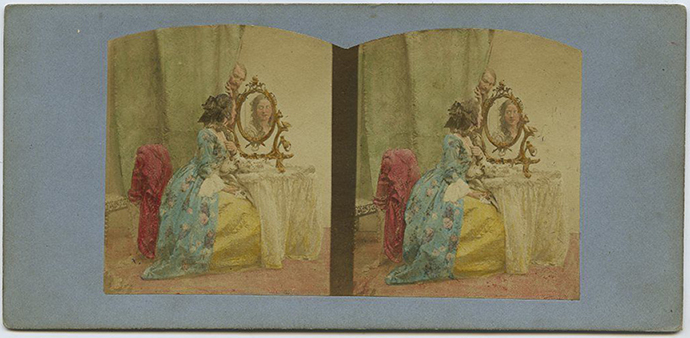What I have been looking at lately…
This Blog is dedicated to sharing imagery and featuring Photographers that have had some influence and have at times been the inspirations to what I make…I am especially interested in sharing artists and imagery which to my experience are less commonly known and circulated…
Stereoview Photographs from 1850s-1860s
I have been looking at stereo photographs or stereoviews (as they are commonly called) again recently. While I had seen stereoviews before (and even collected a small amount of them particularly from the teens and 20s); I have now become especially interested in the earliest of the hand tinted albumen print variety. If you are not at all familiar with stereo cards you are likely to be amazed how remarkable the effect is at such an early time historically. I was absolutely blown away when I first encontered them probably 15 years ago. The bellow example has little albumen prints afixed to a heavy card stock. There were still earlier daguerreotype stereos produced and while I have yet to see one in person; the reproductions in books make it pretty clear that they are nothing short of spectacular. I find it remarkable too how much the tinting or hand coloring varies fom example to example. The tinting ranges from child like naivety to subtle even masterful sophistication. You can view the example pictured below with full 3-dimensional effect directly from this page using a simple plastic viewer.

This next card is the one that launched my interest in the earliest albumen stereos. The subject matter, along with the age and exquisite tinting, all for my purposes make it an exceptional example. It is a visual depiction of the “Male Gaze” formula to such an extent that I would be convinced it were the intention were it to be historically feasable. However the theory as such comes later so it is an interesting happen stance. This card is believed to have been produced in 1853-54 and the tinting is as delicate and subtle as any of the earliest examples which I have yet to see.
 Early tinted stereoview photograph. Woman In Crinoline Looks Into Mirror Genre Scene circa 1854.
Early tinted stereoview photograph. Woman In Crinoline Looks Into Mirror Genre Scene circa 1854.
The next card shows a “Genre Scene” photographed in the artist photographer’s studio incorporating closely directed and posed actresses and actors, painted back drops and and all manner of fabricated props. This is an example where I felt the colors demonstrate a greater garishness and the tinting itself is done with perhaps a lesser degree of sophistication.

The following card is from a “Wedding Day” or “Bride” genre. Since it is perhaps as momentous as any life event to the romantic experience it seems that marital themed tableaux may have been intended as fodder for sentimental reflection and fantasy. Perhaps such images served as a form of, or visual equivallant to; the dreamy romance novel for Victorians of a marrigable disposition.

 Early tinted stereoview photograph. “UNTITLED” English Bride Reflection at Mirror with Her Mother and Maid, Genre scene. Circa 1859 by Elliott, United Kingdom.
Early tinted stereoview photograph. “UNTITLED” English Bride Reflection at Mirror with Her Mother and Maid, Genre scene. Circa 1859 by Elliott, United Kingdom.
 Early tinted stereoview photograph. “CHOOSING WEDDING DRESS” English Bride Chooses Wedding Dress in Stylish Fashion Shop Genre scene. Circa 1859 by Elliott, United Kingdom.
Early tinted stereoview photograph. “CHOOSING WEDDING DRESS” English Bride Chooses Wedding Dress in Stylish Fashion Shop Genre scene. Circa 1859 by Elliott, United Kingdom.
Early Figure Studies, Risque, and Erotic Stereoviews
As with the infamous “French Post Card” after them, there were highly artistic “figure” or “artist studies” created in the stereo photography realm. Here too, (as with the post cards) these artistic and technically sophisticated studios exhibit an obvious respect and influence, or at least knowledge of the classiclly trained academic painters of their era and their precursors who informed them. The classical echoes are in fact at times so unmistakable that one wonders how they have managed to have earned such a completely unflattering reputation. These images look like photographic versions of classical paintings. It would seem somehow that for every pornographic image produced there are as many or more which are very respectable and artistic. Perhaps the Pornographic imagery has cast a shadow upon all genres which incorporate nudity, be they artistic or graphic and coarse. But lets concentrate on stereo photographs for now and plan to get back to the post cards in a separate blog post.
The following stereoview is the only example that i have from the period which we having be addressing. It is a tissue and it has tinting on the back which when held to light colorizes the image in the nicest way. Once again i must resist the urge to continue by for the sake of keeping this a Blog about Early Stereo Photographs I should really wait for a separate posting to enter into the next eras. I will give a preview of what the late Century looked like and as you can quickly see the varying levels of sophistication continue be that a charming aspect of this medium or not.

The preview image comes (1890 or 1900) almost 50 years later. It is the same theme as we have above, that of the exposed stockings or forbidden view of the legs. Still a central theme to Erotic and Risque imagery after another 50 years (1945) and today.
 “Come Play With Me” About 1890 or 1900. Published in U.S.A.
“Come Play With Me” About 1890 or 1900. Published in U.S.A.
